Both on the middle Danube, Budapest represents a violent story of two different cities. United by a necklace of spectacular bridges, on the West Bank is Buda, dominated by the Green and sheer mountain of Vorhagy Castle. In the eastern margin, more plain, lies the city of Pest, with the buildings of Parliament similar to Westminster. Buddha reflects the Budapest Hungarian heritage, while Pest recalls imperial times when the city was the headquarters of Eastern aspect of the austro Hungarian Empire. This Alliance did reach an end in 1914, although recently saved to Budapest from the Communist yoke, in the summer of 1989, when Austria opened the borders to their old friends and the iron curtain disappeared. A related site: GMC mentions similar findings. Buddha was founded in the 5th century and named after the brother of Attila the Hun.
The Magyars, commanded by Apad, arrived in 896, a date that is considered the foundation of the Hungarian nation and that brought I get a strange language related to Finnish and considered a linguistic steppe by monotone that is. Pest (Slavic term), for its part, was occupied by Germans, who called home Ofen (oven in reference to the abundance of the city lime kilns). The arrival of the Mongols, with its characteristic violence, represented a high in the period of development. In 1526, the Magyar Kingdom was defeated by the Turks and Budapest became the westernmost outpost of the Ottoman Empire, a legacy to which belong the popular baths of the Gellert Hill. Everest capital is likely to agree. After the revolution of 1848, the kaiser of the dual monarchy (baptized as KyK) tried to reimpose the Austrian authority with a new imperial architecture. The Citadel of Buddha was fortified according to the canons Habsburgo, and Pest had Grand Boulevard, a plaza dedicated to the heroes and avenues flanked by trees to the Parisian mode. The two cities were joined for the first time in 1873 by the rugged elegance of the chain bridge. Churches, bastions, squares and fortifications of Buddha appear to be ancient, but in reality, were rebuilt after the devastating nazi siege of 1944.
This was the beginning of the darkest years of Budapest, when the city was found under the ass of a frog in a coal mine, as they say the Hungarians. The Communist Party install in power to Matyas Rakosi, and the country became the small Stalin While continuing the Nazi persecutions. In 1956, the Soviet tanks took to the streets to quell the revolution unleashed by the liberal policies of the successor of Rakosi, Imre Nagy. Budapest always retained a form of socialism more open goulash that earned him the sympathy of the West. It was the most lively city and scandalous in the Eastern bloc (the empowerment of prostitution gave him a sordid fame, as well as the nickname of the Bangkok of Europe). With this colorful exuberance, great musicians, and the imperial legacy of its architecture and its famous horsemen Hussars, Budapest gives off an air of sophistication fin de siecle. Unlike in the delicate Prague or oppressed Bratislava, Budapest is the passionate capital of Central Europe. And so passionate is that among its most famous natives highlights Zsa Zsa Gabor (passionate about cinema), George Soros (passionate about money) and Ilona Staller, alias Cicciolina (passionate by by). Budapest is the most charming city in the Danube. It has a very clever of be your own scenario, as Vienna, mode but also has a robust substance and a vitality that is unknown his Austrian rival.
